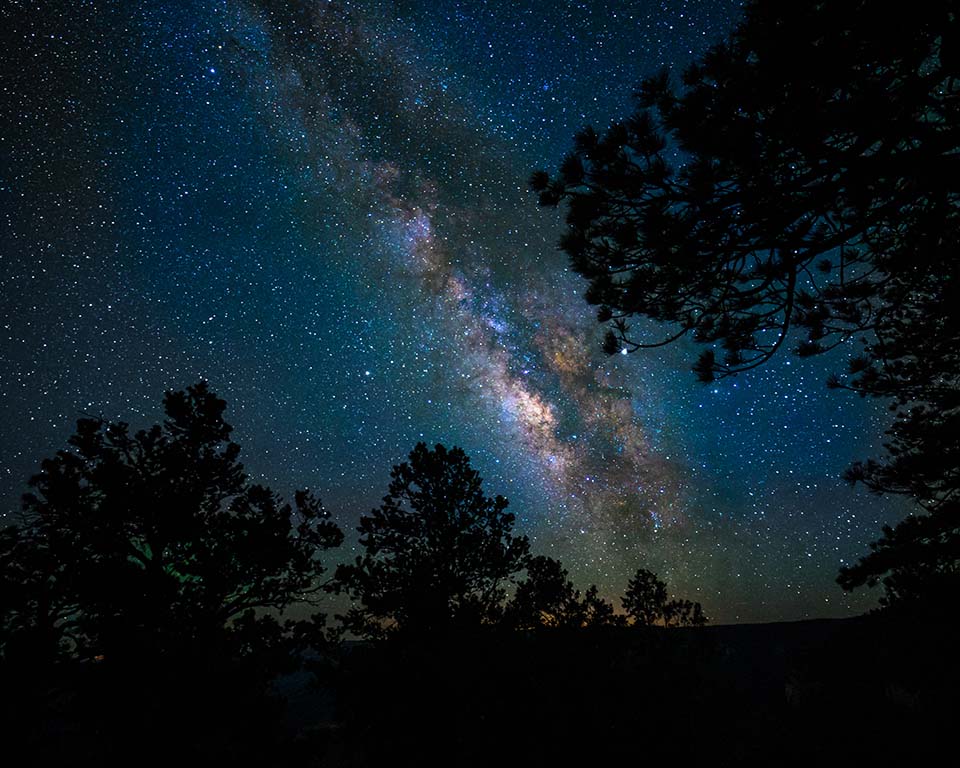
--Grand Canyon. Photo by Jim Dublinski.
Light Pollution and Night Skies
NJ communities are drowning in light pollution. We’re increasingly flooded with 24/7 bright light in urban, suburban and even rural areas. Too much light is harmful: bad for our health and bad for wildlife. Aggressively bright light is also a social justice issue affecting communities of color. Join us to help bring back our night skies.
"So who owns the night sky? The answer seems simple to me. No one does, and therefore we must collectively care for the sky as a global commons. When taken with a broader view towards climate change, global exploitation, the patriarchy, colonialism, unmitigated growth, extractive industry, and environmental destruction, as well as advancement, progress, and equality, we see the interconnectedness of everything."
M. Eaves “Who owns the night sky” Nightscape (2021, Dec)
Protecting Our Night Skies
When you look up to the heavens, do you wish you could see the Milky Way in all of its glory? Is bright lighting in parking lots and around buildings the best way to provide safety? What are the impacts of extended night lighting on wildlife? On human health? In urban and low-income communities? Can we balance our very human fear of the dark with the recognition that our use of artificial lighting has gotten out of hand?
Our Overnighting Problem
New Jersey’s communities are drowning in light pollution. The use of artificial light continues to increase exponentially, not just in urban but suburban and even rural areas. Whether it comes from streetlights, brightly lit parking areas, residences, roads, buildings, bridges and billboards, light “cannons” and spotlights, sports fields, stadiums, or vehicle lights, our world is increasingly flooded with light, both day and night. As LED lighting gets cheaper, instead of using it to save energy we often simply light more and more things, more brightly.
Excess light is a problem for many reasons. All creatures, both plant and animal, have evolved to need both day and night. When light disrupts our sleep-wake patterns, we are more vulnerable to diabetes, weight gain, and depression. Light pollution can weaken the human immune system. For wildlife, lack of natural light and darkness patterns can disrupt the feeding, sleeping, hunting, reproduction and migratory cycles of many animals. Some of those that have been studied include sea turtles, bats, birds, insects, fish, corals and bioluminescent species. Artificial light has also been documented to affect the timing of flowering, pollination, growth and dormancy in many plants.
Overlighting as a Social Justice Issue
A mix of inadequate and excessive lighting is often prevalent in lower-income areas, including communities of color. Economically disadvantaged communities often lack the financial resources or political power to advocate for well-directed and aesthetically pleasant lighting. Bright lighting is often associated with “safety” and may be used or perceived as a form of policing or aggression. Excess lighting in these areas contributes to increased stress, loss of sleep, and adversely affected human health. On the other hand, well-conceived lightning can enhance a pedestrian’s confidence, encouraging them to walk at night rather than drive, or stay “trapped” at home.
Working to Increase Wise and Efficient Use of Outdoor Lighting
Well-directed lighting – no more than and no brighter than needed – can increase visibility and safety and help provide wayfinding on highways. Our Chapter’s Light Pollution and Night Skies Committee is working to pass legislation and promote rules that encourage wise and efficient use of outdoor lighting. We share the goal championed by the International Dark-Skies Association: to restore the natural nighttime environment.
We advocate for intelligent, dynamic road lighting that continually adapts to the presence and behavior of a driver or pedestrian. We are committed to removing unnecessary lighting that acts as a form of cultural and social injustice by denying residents access to the psychological and recreational enjoyment of starry night skies.
Existing street lamps that spill light in all directions, including rooftops, can be replaced with intelligent, dynamic lighting that can help preserve a community’s night sky. We advocate that all outdoor lighting point to the ground, not the sky, and that all lights and illuminated signs dim when there is no traffic. Efficient, well-placed, and designed lights can increase safety, reduce costs, and enhance the night environment in our communities.
What You Can Do
There's a lot you can do! In addition to taking personal steps, like using lights rated below 3000k brightness and reducing unnecessary lighting in and around your home, you can advocate in your community for common sense curbs on nighttime illumination.
Work to develop local light pollution ordinances and more sustainable community lighting choices. Municipalities often make decisions about lighting public areas, schools and playing fields. Just a few voices like yours can make a big difference in the decisions that are made.
Help support us and we can support you! Contact our Committee Chair.
Resources
The International Dark-Sky Association website offers many resources on light pollution. Check out their outreach materials page for fact sheets, infographics and brochures with important facts on light pollution.